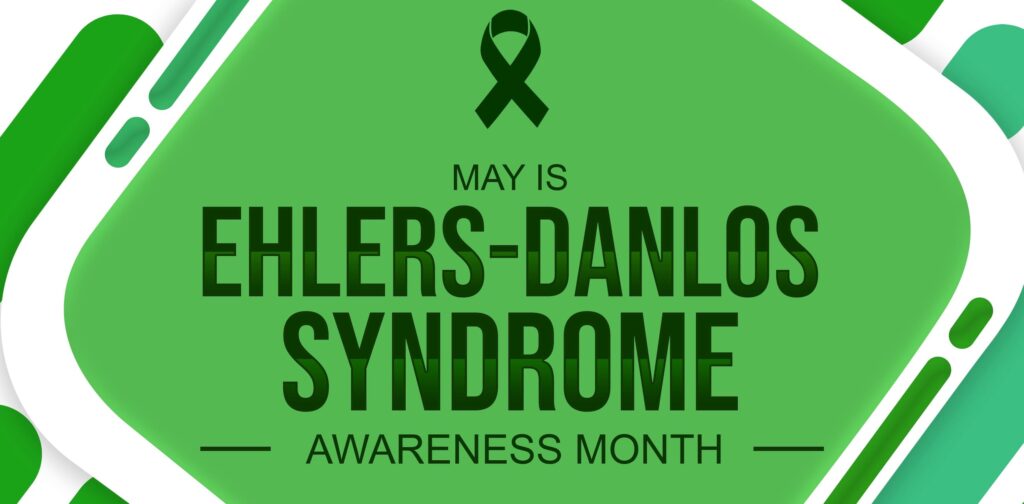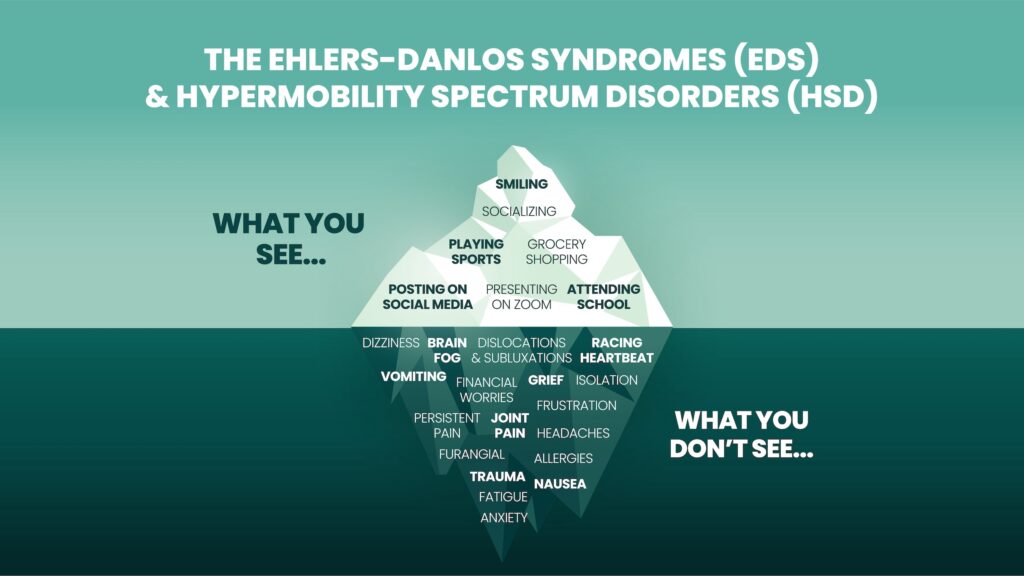🧠 EDS Is Not Just About Joint Pain
One thing the world—and the medical community—should understand about Ehlers-Danlos Syndrome (EDS): it’s not just about being “too flexible” or “having joint pain.”
EDS is a complex, multisystem disorder that affects connective tissue throughout the body: joints, skin, blood vessels, nerves, digestion, and even mental health. Patients often look fine on the outside, but standard labs and imaging don’t tell the full story.
Many go years—sometimes decades—without a diagnosis. Along the way, they are often mischaracterized as anxious, dramatic, or somaticizing. In reality, they’re battling chronic pain, joint instability, autonomic dysfunction, fatigue, and brain fog on a daily basis.

🧪 What’s Really Going on in the Body
EDS is commonly underdiagnosed because most physicians aren’t trained to recognize it. This leads to missed diagnoses, unnecessary surgeries, over-medication, and deep psychological harm.
Validating patients and listening carefully can be life-changing—and sometimes life-saving.

Many patients with EDS, especially hypermobile EDS (hEDS), experience dysautonomia: a dysfunction of the autonomic nervous system.
This often involves an overactive adrenergic (sympathetic) system, which releases stress chemicals called catecholamines:
- Norepinephrine (a brain and spinal cord neurotransmitter)
- Adrenaline (released into the bloodstream, affecting many organ systems)
When catecholamine levels stay elevated, the nervous system remains in high alert, leading to:
- Panic-like symptoms, anxiety, and chronic fatigue
- Dizziness, heart rate changes, and blood pressure swings
- Postural Orthostatic Tachycardia Syndrome (POTS), common in EDS patients
🔥 Pain, Inflammation, and the Brain
1. Chronic Pain & Central Sensitization
An overactive sympathetic system can amplify pain signaling, leading to widespread, persistent pain. This often contributes to depression, insomnia, and irritability.
2. Mast Cell Activation & Neuroinflammation
Some individuals with EDS also meet criteria for mast cell activation syndrome (MCAS), which can trigger systemic inflammation—including in the brain.
Neuroinflammation is linked to:
- Brain fog
- Mood disorders
- Cognitive issues and emotional dysregulation
Elevated catecholamines can activate mast cells and worsen inflammation, creating a feedback loop between stress and immune response.
🔌 Neurodivergence and Nervous System Wiring
In individuals with hypermobile EDS, research shows elevated rates of:
- ADHD
- Autism Spectrum Disorder (ASD)
- Sensory Processing Disorder
- Possibly Tourette’s Syndrome
These neurodevelopmental overlaps may stem from shared genetic pathways and connective tissue biology, affecting both brain development and nervous system regulation.

💔 When Medicine Gets It Wrong
1. Misdiagnosis and Delayed Diagnosis
It takes 10+ years and 15+ doctors on average for an EDS diagnosis. Early signs like hypermobility or chronic pain are often dismissed, especially in hEDS.
Misdiagnoses may include:
- Fibromyalgia
- Chronic fatigue syndrome
- Somatic symptom disorder
- Conversion disorder
The result? Medical trauma, emotional distress, and eroded trust.
2. Functional Impairment
Joint instability, fatigue, and chronic pain often lead to:
- Social isolation
- Loss of identity
- Reduced independence, especially in adolescents and young adults
3. Medication and Treatment Burden
Without an accurate diagnosis, many patients are prescribed medications (e.g., sedatives, painkillers) that may be ineffective or harmful.Many also undergo unnecessary surgeries, despite increased surgical risk in EDS due to tissue fragility and poor healing.
🦜 Common Mental Health Conditions in EDS
| Condition | Notes |
|---|---|
| Anxiety Disorders | Often tied to autonomic dysregulation and panic-like symptoms |
| Depression | Linked to chronic pain, isolation, and repeated invalidation |
| ADHD | Common in hEDS; overlaps with cognitive fatigue and executive dysfunction |
| Autism Traits | Increased prevalence; impacts sensory/social processing |
| Somatic Symptom Disorder | A frequent misdiagnosis for undiagnosed EDS patients |
| PTSD | May result from medical trauma, ongoing stress, or injury |
🌿 Why Listening—and Believing—Matters
Ehlers-Danlos Syndrome is not rare. It’s just rarely recognized. And when it’s misunderstood, the consequences for patients can be devastating.
We must move past stereotypes and begin seeing EDS through a neurobiological, systemic lens. The links between connective tissue, the nervous system, and mental health are real, measurable, and deserving of care.
If you or someone you love is navigating EDS, know this: You are not alone. You deserve to be heard, believed, and supported.
At NW Regen, we take a whole-body, trauma-informed approach to regenerative care.
Learn how we can support your healing journey. Contact us to set up a consultation, or give us a call at (503) 799-6115.

Dr. Ryan Wood is a licensed Naturopathic and Chiropractic physician focusing on interventional orthopedic and orthobiologic medicine and injection therapies as well as general musculoskeletal and non-surgical orthopedic medicine.
With almost two decades of orthopedic practice across multiple disciplines, he has the necessary experience to ensure proper diagnoses and management of complex cases.


